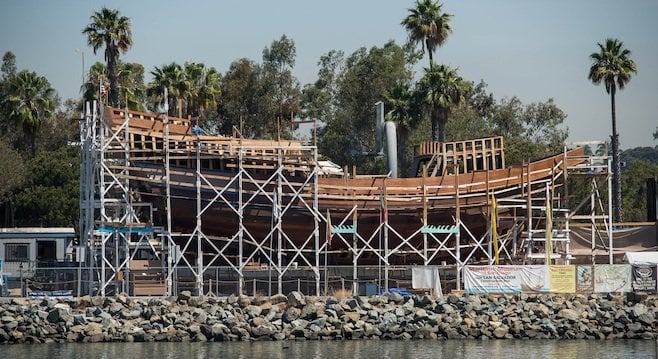 Facebook
Facebook
 X
X
 Instagram
Instagram
 TikTok
TikTok
 Youtube
Youtube

Almost hidden behind a large fence in the Spanish Landing area of San Diego Bay, directly across from Lindbergh Field, sits the ongoing, full-scale, re-creation of Juan Rodríguez Cabrillo’s Spanish galleon. The San Salvador delivered the first Europeans to what would become California — and San Diego — on September 28, 1542.
It’s being re-created by volunteer woodworking craftsmen and hobbyists. They cut and shape masts, beams, and decking from some of the world’s most exotic woods. The replica’s woods were chosen for their strength and resistance, finished beauty, and the ability to withstand the ocean’s swells.
Angelique (also known as Guiana teak) from French Guiana and Suriname, is used in the keel. Apotong from Southeast Asia, India, and Brazil, is mostly used in the stern. Purple Heart (aka violet wood), the heaviest and most beautiful, a very dense and hard wood from Central and South America, is used on the keelson, stern structure, and the frame. Wood used to re-create the rudder weighs 4500 pounds and cost $13,000. Sapele is a brown mahogany-looking wood found in tropical Africa. It is also used in guitar-making and on the dashboards of high-end Cadillacs. The Sapele wood arriving is labeled as being from the Congo. It’s used on the planking and bow. It’s known for its resistance to marine parasites.
Most hardwood used on the ship is so heavy and dense, if placed in the water by itself, it would sink. The boat should hit the water by November of this year — be ready for tours and sailing by next summer. The museum plans a goodwill cruise up the coast, stopping at ports-of-call along the way.
The San Diego Maritime Museum’s build site is open to the public for exterior viewing of the ship’s progress and historical displays. A gift shop sells letter openers and oak-leaf dishes carved out of leftover pieces of the woods. Build site is at 4300 North Harbor Drive. 619-234-9153. Open 11:00 a.m.–4:00 p.m. daily. $5.00 admission. Free four-hour parking.


Almost hidden behind a large fence in the Spanish Landing area of San Diego Bay, directly across from Lindbergh Field, sits the ongoing, full-scale, re-creation of Juan Rodríguez Cabrillo’s Spanish galleon. The San Salvador delivered the first Europeans to what would become California — and San Diego — on September 28, 1542.
It’s being re-created by volunteer woodworking craftsmen and hobbyists. They cut and shape masts, beams, and decking from some of the world’s most exotic woods. The replica’s woods were chosen for their strength and resistance, finished beauty, and the ability to withstand the ocean’s swells.
Angelique (also known as Guiana teak) from French Guiana and Suriname, is used in the keel. Apotong from Southeast Asia, India, and Brazil, is mostly used in the stern. Purple Heart (aka violet wood), the heaviest and most beautiful, a very dense and hard wood from Central and South America, is used on the keelson, stern structure, and the frame. Wood used to re-create the rudder weighs 4500 pounds and cost $13,000. Sapele is a brown mahogany-looking wood found in tropical Africa. It is also used in guitar-making and on the dashboards of high-end Cadillacs. The Sapele wood arriving is labeled as being from the Congo. It’s used on the planking and bow. It’s known for its resistance to marine parasites.
Most hardwood used on the ship is so heavy and dense, if placed in the water by itself, it would sink. The boat should hit the water by November of this year — be ready for tours and sailing by next summer. The museum plans a goodwill cruise up the coast, stopping at ports-of-call along the way.
The San Diego Maritime Museum’s build site is open to the public for exterior viewing of the ship’s progress and historical displays. A gift shop sells letter openers and oak-leaf dishes carved out of leftover pieces of the woods. Build site is at 4300 North Harbor Drive. 619-234-9153. Open 11:00 a.m.–4:00 p.m. daily. $5.00 admission. Free four-hour parking.
Comments